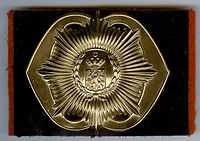Regiment van Heutsz
| Regiment van Heutsz | |
|---|---|
|
Cap badge of the Regiment van Heutsz with backing | |
| Active | 1950– |
| Country |
|
| Allegiance |
|
| Branch | Army |
| Type | Line infantry |
| Role |
Air Assault Infantry Low Level Air Defence |
| Size |
1 battalion 1 company |
| Garrison/HQ | Schaarsbergen |
| Colors | Black and Orange |
| March | van Heutsz Mars |
| Engagements |
Hill 325, Iron Triangle 1951 Koje-do Island POW revolt 1952 Hill 340, Iron Triangle, 1953 |
| Decorations |
US Presidential Unit Citation, Dutch Cross for Justice and Freedom |
| Battle honours |
Hoensong-Wonju Soyang |
| Commanders | |
| Notable commanders |
Lt. Col. M.P.A. den Ouden †[1] Lt. Col. W.D.H. Eekhout[2] Lt. Col. G.H. Christian [3] Lt. Col. C.M. Schilperoord[4] |
The Regiment van Heutsz is a line infantry regiment of the Royal Netherlands Army. The regiment was named after J.B. van Heutsz a former Governor-General of the Dutch East Indies, and was formed on July 1, 1950. It is notable for its service as part of the United Nations force sent to fight during the Korean War. It is still operational and has served tours as part of the ISAF Afghanistan Mission.
Korean War
- See also Battles of the Korean War involving the Netherlands (Category)
The van Heutsz Regiment was incorporated into the Nederlands Detachement Verenigde Naties (NDVN) (English: Netherlands Detachment United Nations) which also included the Dutch Naval component sent to Korea. 16,225 people volunteered for service in Korea of whom only 3,418 men were accepted and sent to Korea. Because 516 men volunteered twice and 38 men three times a total of 3,972 men served in Korea. 2,980 of those participated in the actual war, as the units that arrived after the armistice (July 27, 1953) did not participate in any fighting.[5]
The van Heutsz regiment was only recently raised when the Korean War battalion was formed on October 26, 1950, but took the detachment as its first battalion. The regiment has the battle honor Korea 1950–1954 on its colors. In Korea, the van Heutsz troops (being understrength) were re-enforced by South Korean "KATUSA" troops. The Dutch served at three key battles, all around the Iron Triangle sector between 1951 and 1953.
Since the Regiment van Heutsz did not have its colors in 1950, a Dutch flag that was used in Korea as the battle flag of the Nederlands Detachement Verenigde Naties became the regimental colour. This flag now has official status and is shown on every parade and function of the regiment. American and Korean battle streamers, representing the US Presidential Unit Citation, are attached to this flag.[6]
The Regiment suffered 116 Dutch and 20 attached-Korean soldiers killed in action, three soldiers are still MIA, while one Dutchman was taken prisoner and died in a North Korean POW camp. The Dutch casualties are buried at the United Nations Memorial Cemetery in Busan, including their commander, Lt. Col. Marinus Petrus Antonius den Ouden, who was killed in action during Operation Roundup in 1951. (Posthumously, den Ouden was received Netherlands' highest military award, the Military Order of William.) A total of 381 soldiers were wounded.[7]
Post Korean Service and ISAF Deployment
The traditions of the Regiment van Heutsz are currently maintained by two units serving as part of 11 Luchtmobiele (Airmobile) Brigade:[8]
- 12 Infanterie Bataljon is one of three air assault infantry battalions within the air mobile brigade
- 11 Luchtverdedigingcompagnie is the brigade's low level air defence unit
From 2006 till 2010, the battalion formed the basis of the battlegroup attached to Task Force Uruzgan, the primary Dutch component of the multi-national forces in Afghanistan. The regiment maintains the traditions of the Koninklijk Nederlands Indisch Leger.
See also
- Garderegiment Grenadiers en Jagers
- Regiment Stoottroepen Prins Bernhard
References
- ↑ http://www.koreanwar-educator.org/topics/national_archives_103.htm
- ↑ http://www.koreanwar-educator.org/topics/national_archives_103.htm
- ↑ http://www.koreanwar-educator.org/topics/national_archives_103.htm
- ↑ http://www.koreanwar-educator.org/topics/national_archives_103.htm
- ↑ http://www.korean-war.com/netherlands.html
- ↑ DUTCH PARTICIPATION IN THE KOREAN WAR
- ↑ http://www.korean-war.com/netherlands.html
- ↑ "11 Luchtmobiele Brigade" (in Dutch). Dutch Ministry of Defence. Retrieved 2011-03-10.
VOKS Vereniging Oud Korea Strijders / Korea Combatant Club
External links
- Official history of the Dutch participation in Korea
- Website Regiment van Heutsz
- Korean War History of NDVN
- Dutch participation in the Korean War
- (Dutch) Dutch Re-enactment unit, NDVN 1953
- (Dutch) van Heutsz Regiment in Korea
| ||||||||||||||||||||||
